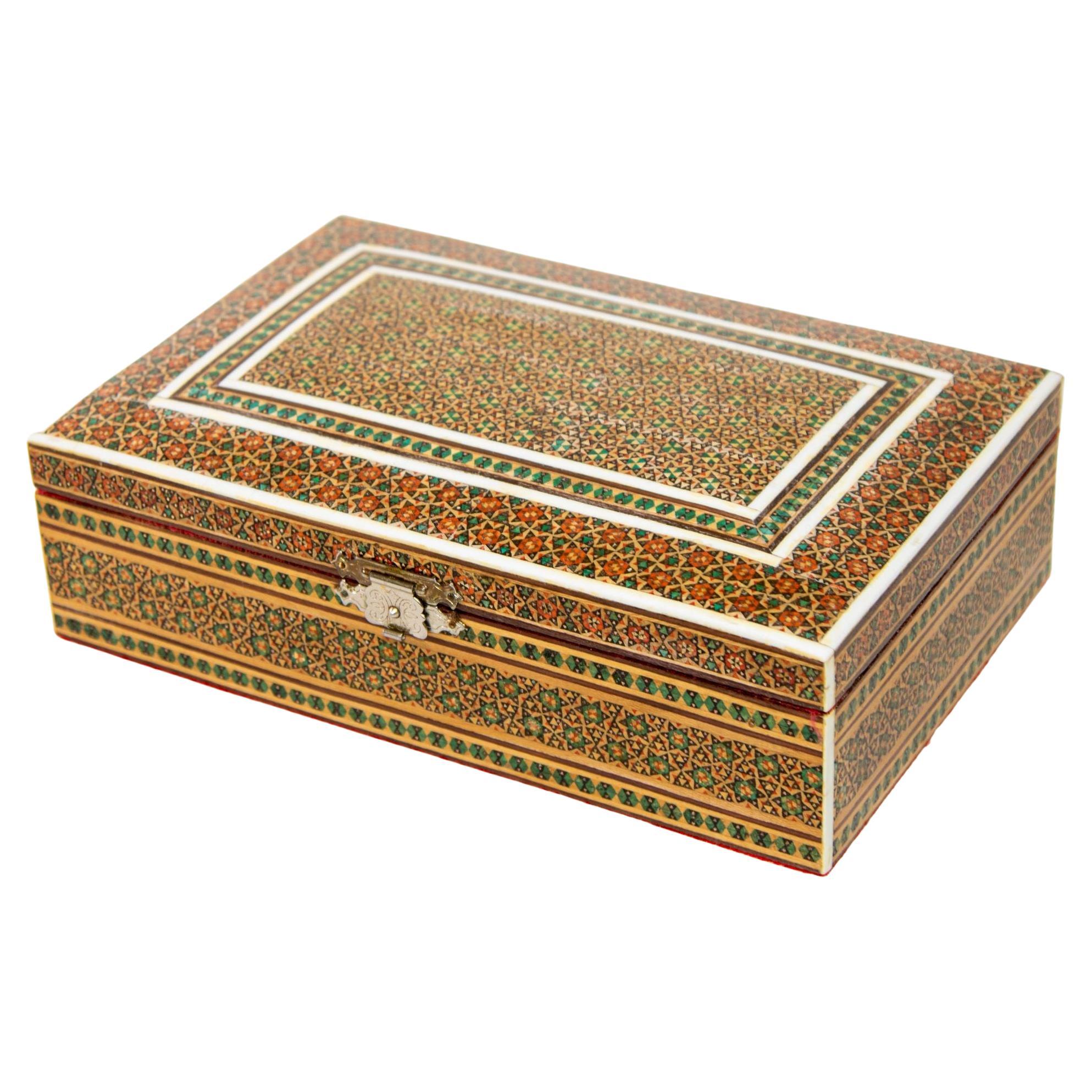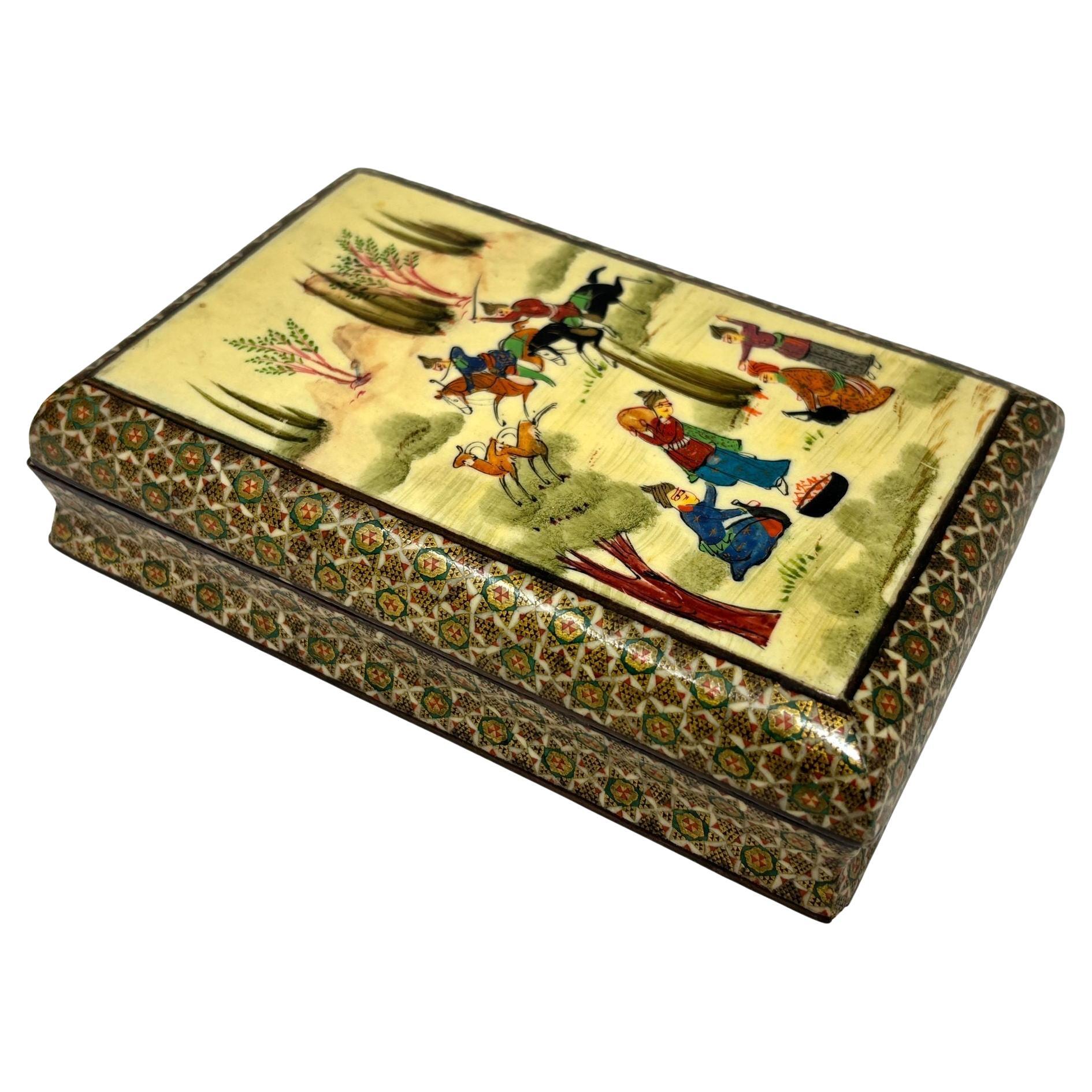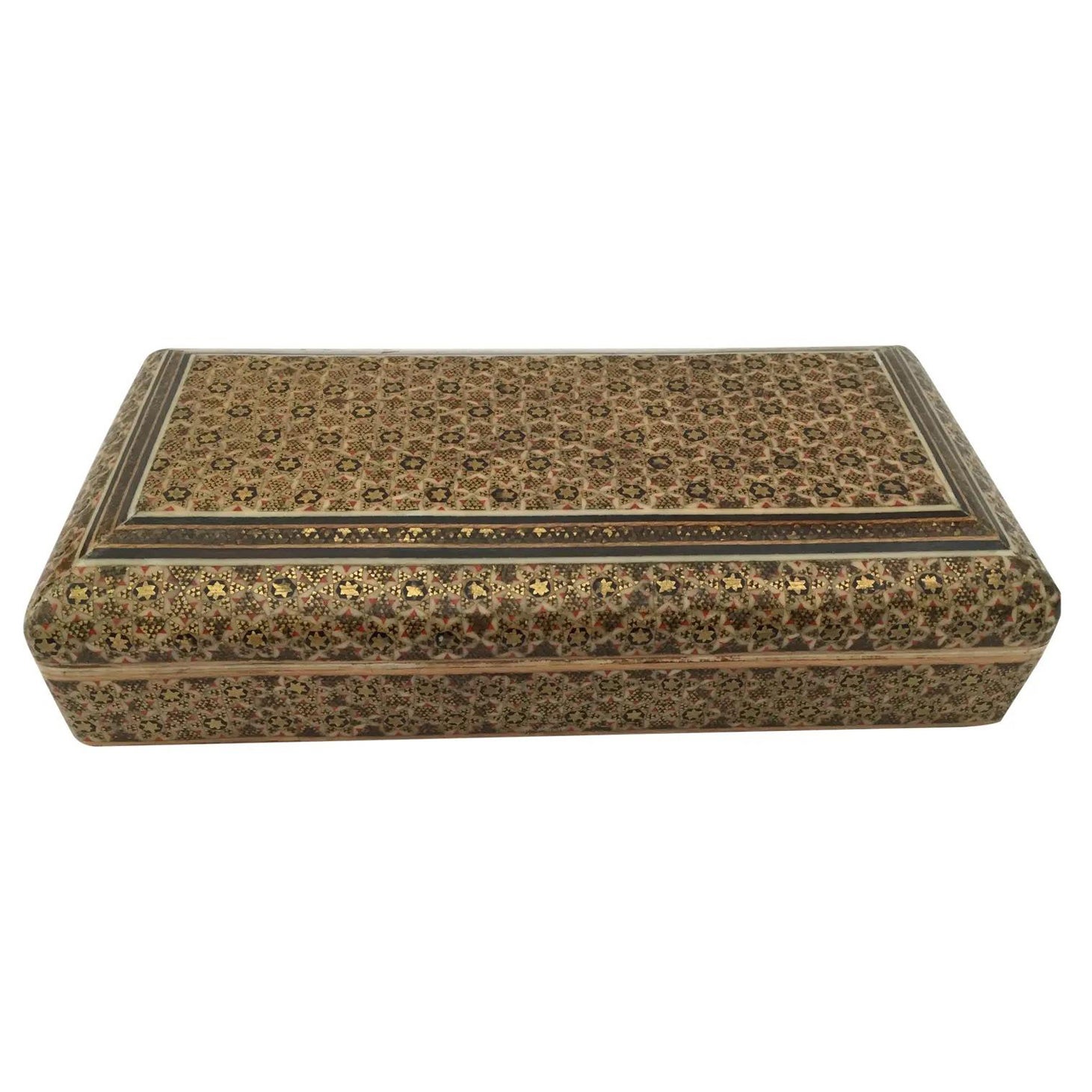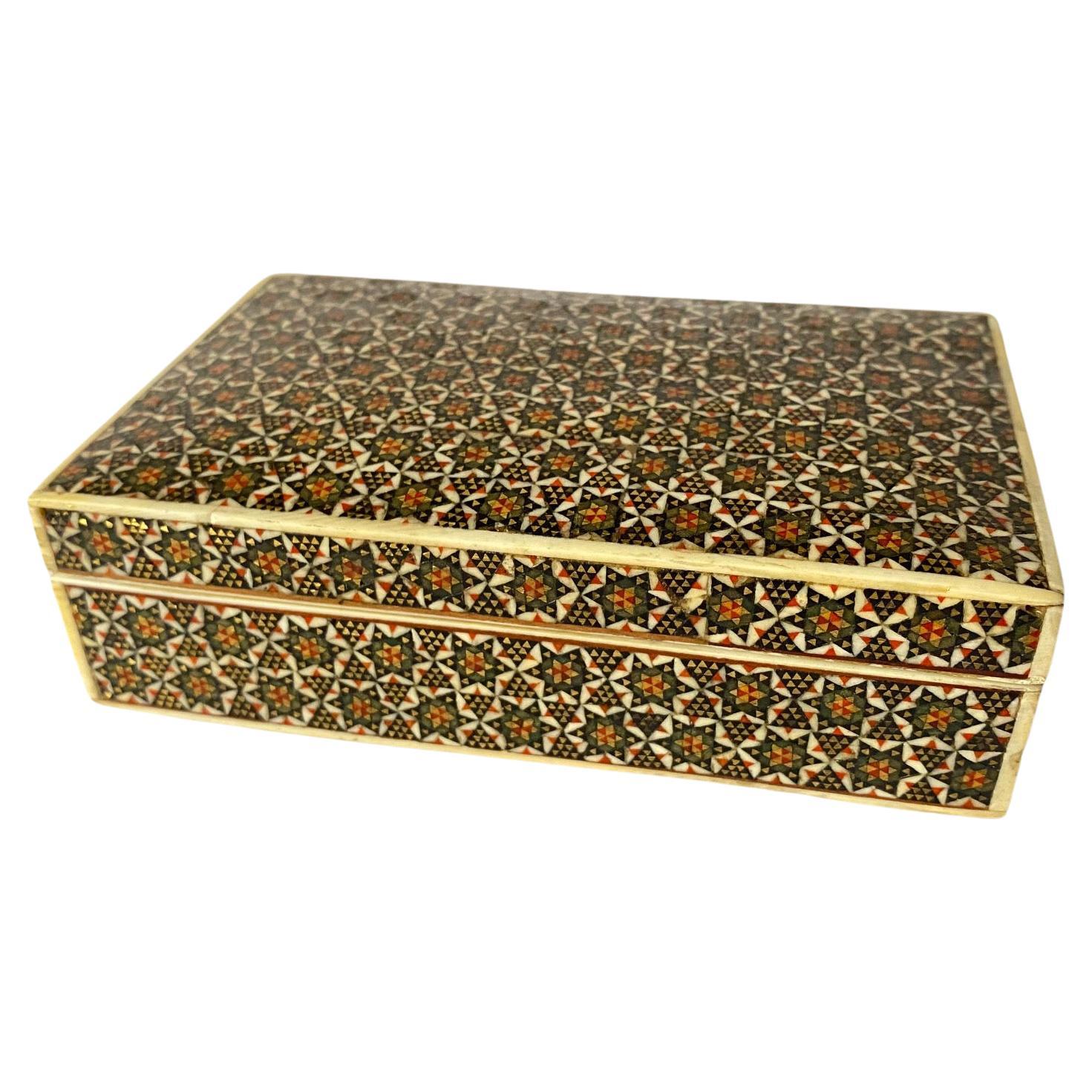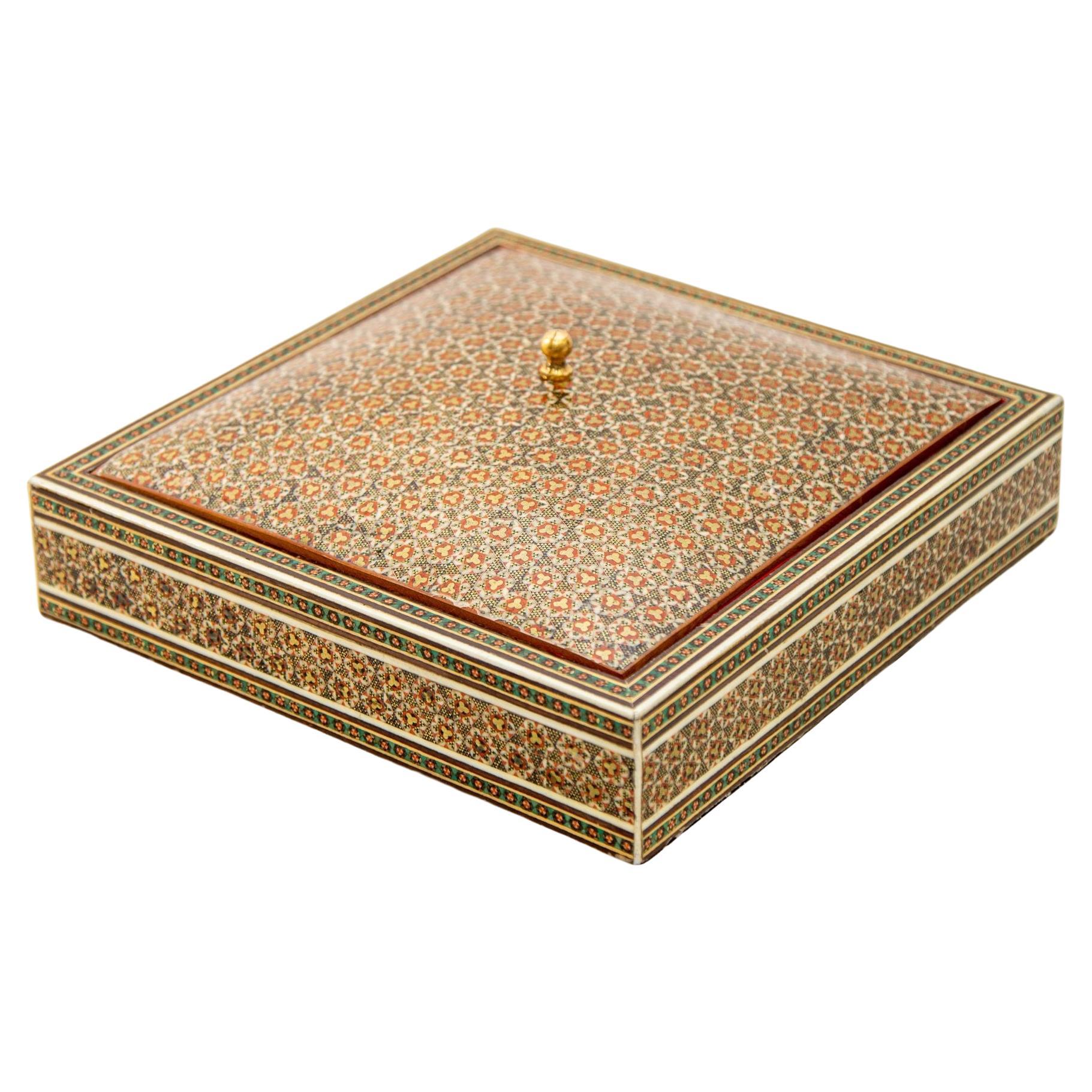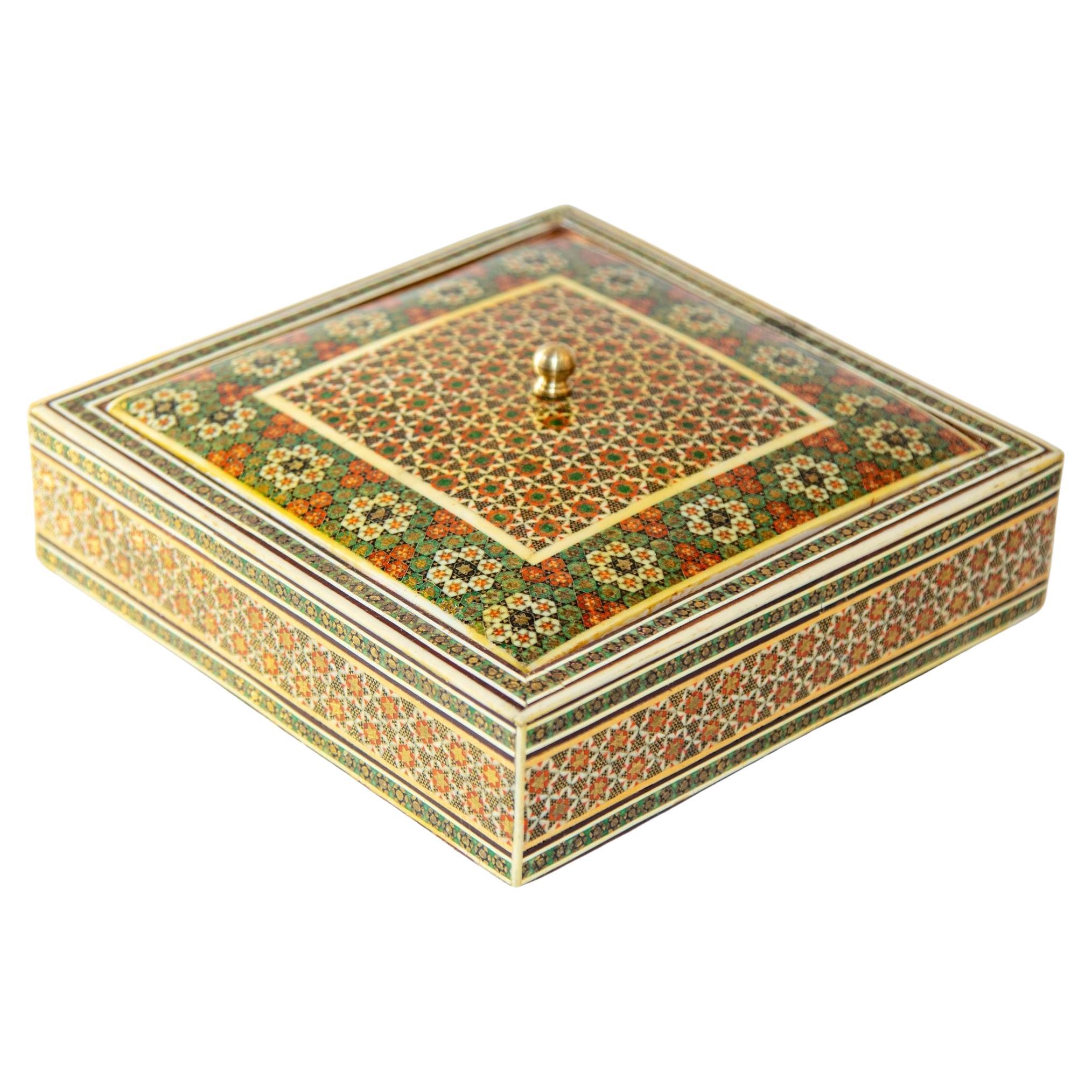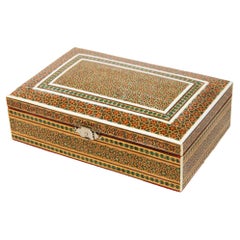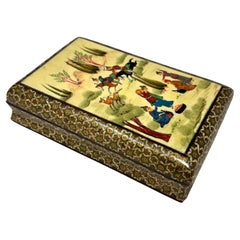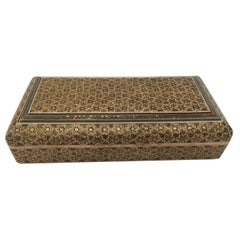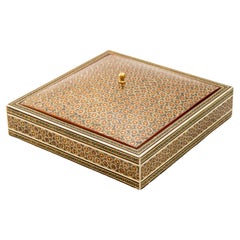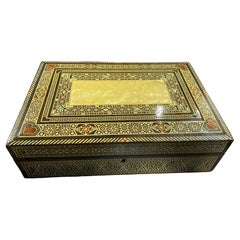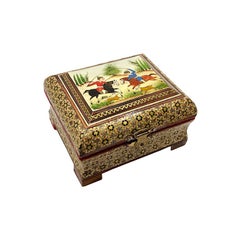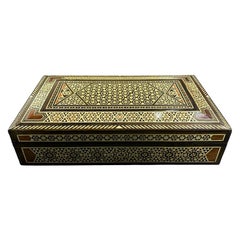Items Similar to Antique Persian Khatam Micro Mosaic Inlaid Jewelry Box circa 1940s
Video Loading
Want more images or videos?
Request additional images or videos from the seller
1 of 13
Antique Persian Khatam Micro Mosaic Inlaid Jewelry Box circa 1940s
$495
£373.78
€430.74
CA$698.66
A$770.25
CHF 402.97
MX$9,449.56
NOK 5,072.60
SEK 4,743.69
DKK 3,216.77
About the Item
Antique Persian Khatam Micro Mosaic Inlaid Jewelry Box with Miniature Polo Scene, circa 1940s
This exquisite Persian Khatam Kari trinket box is a rare example of masterful micro mosaic marquetry, handcrafted in the 1940s using the ancient Persian art of inlay.
Featuring an intricately detailed geometric design and a miniature hand-painted equestrian scene on the lid, this museum-quality piece is a stunning representation of Indo-Persian and Moorish craftsmanship.
Khatam Kari, or Persian marquetry, is a centuries-old decorative art that flourished during the Safavid dynasty. It involves the meticulous inlay of thousands of tiny pieces of wood and bone into intricate, repeating geometric patterns—each symbolic of harmony and cosmic order. The top of this box is adorned with a finely rendered painting of royal figures on horseback, possibly princes engaged in a ceremonial game of polo, echoing the refined court culture of the 19th-century Persian and Mughal aristocracy.
The box’s micro mosaic surface is covered in richly detailed star and polygon motifs typical of Khatam and Sadeli mosaic traditions.
These patterns require precise mathematical planning and exceptional artisanal skill, resulting in a surface that is as intellectually complex as it is visually stunning.
Details:
* Origin: Asia Indo-Persian
* Date: Circa 1940s
* Materials: Inlaid woods, camel bone, hand-painted miniature
* Style: Islamic Art, Moorish, Anglo-Indian, Micro Mosaic
* Dimensions: Height 1.5 in. x Width 6.5 in. x Depth 4.25 in.
* Condition: antique condition with minor wear consistent with age
These boxes were traditionally used to store writing instruments or jewelry, and today they serve as timeless collectors' pieces, suitable for display or thoughtful gifting.
Comparable examples can be found in major Islamic art collections, including the Doris Duke Museum of Islamic Art.
Keywords:
Persian Khatam Box, Micro Mosaic Jewelry Box, Islamic Marquetry, Moorish Trinket Box, Middle Eastern Miniature, Anglo-Indian Inlay Box, Antique Persian Art, Islamic Decorative Art, Museum Quality Khatam Kari, Polo Scene Miniature Box
- Dimensions:Height: 1.5 in (3.81 cm)Width: 6.5 in (16.51 cm)Depth: 4.25 in (10.8 cm)
- Style:Anglo-Indian (In the Style Of)
- Materials and Techniques:
- Place of Origin:
- Period:
- Date of Manufacture:1940
- Condition:wear consistent with age and use.
- Seller Location:Moreno Valley, CA
- Reference Number:Seller: PB7251stDibs: LU906845891942
About the Seller
5.0
Platinum Seller
Premium sellers with a 4.7+ rating and 24-hour response times
1stDibs seller since 2011
3,104 sales on 1stDibs
Typical response time: 1 hour
- ShippingRetrieving quote...Shipping from: Moreno Valley, CA
- Return Policy
Authenticity Guarantee
In the unlikely event there’s an issue with an item’s authenticity, contact us within 1 year for a full refund. DetailsMoney-Back Guarantee
If your item is not as described, is damaged in transit, or does not arrive, contact us within 7 days for a full refund. Details24-Hour Cancellation
You have a 24-hour grace period in which to reconsider your purchase, with no questions asked.Vetted Professional Sellers
Our world-class sellers must adhere to strict standards for service and quality, maintaining the integrity of our listings.Price-Match Guarantee
If you find that a seller listed the same item for a lower price elsewhere, we’ll match it.Trusted Global Delivery
Our best-in-class carrier network provides specialized shipping options worldwide, including custom delivery.More From This Seller
View AllMiddle Eastern Persian Micro Mosaic Khatam Inlaid Jewelry Box
Located in Moreno Valley, CA
Large Middle Eastern Indo-Persian Micro Mosaic Khatam Inlaid Wooden Jewelry Box.
Middle Eastern Persian Sadeli micro mosaic marquetry inlaid box with geometric Moorish design.
Handcrafted Khatam wooden box with very delicate micro mosaic marquetry from the ancient Middle Eastern technique of inlaying from arrangements of so many delicate pieces of precious hand painted wood, with bone around the edges.
This beautiful Middle Eastern Persian, Indian Wooden box is covered with fine Moorish micro mosaic marquetry and is used as a jewelry, trinket box.
Lined in deep red velvet.
Dimensions: 6.5in.D x 3in.H x 10 wide.
Nice Indian Mughal, Indo Persian Box...
Category
Mid-20th Century Indian Moorish Jewelry Boxes
Materials
Fruitwood
Fine Indo-Persian Micro Mosaic Marquetry Box with Miniature Painting 1940s
Located in Moreno Valley, CA
Fine Micro Mosaic Indo Persian Moorish Inlaid Trinket Jewelry Box with Miniature Polo Scene, circa 1940s
Exceptional handcrafted Indo-Persian jewelry or pen box featuring intricate Sadeli micro mosaic marquetry with inlaid geometric designs and a stunning miniature hand-painted scene on the lid. The artwork depicts 19th-century royal princes in traditional Maharaja attire playing polo, reflecting Mughal and Islamic courtly elegance.
Crafted using the traditional Khatam technique, the box is richly inlaid inside and out with fine slivers of wood, bone, and metal, showcasing exceptional craftsmanship from the Middle East or India, circa 1940s.
* Dimensions: H 1.75 in. x W 6.5 in. x D 4 in.
* Condition: great condition; minor wear consistent with age.
A museum-quality piece comparable to those in the Doris Duke Islamic Art Collection. Perfect for collectors of Islamic art, Moorish marquetry, and antique micro mosaic.
Keywords:
Islamic Marquetry, Sadeli Mosaic, Khatam Box...
Category
Mid-20th Century Indian Anglo Raj Decorative Boxes
Materials
Fruitwood
Indo-Persian Khatam Micro Mosaic Jewelry Box
Located in Moreno Valley, CA
Handcrafted Khatam wooden box with very delicate micro mosaic marquetry from the ancient Persian technique of inlaying from arrangements of so many delicate pieces of wood, precious wood, and delicate miniatures paintings.
This beautiful Middle Eastern Persian style box is covered inside and out with fine Moorish micro mosaic marquetry.
Indo Persian Moorish style micro mosaic inlaid jewelry box with lid.
Intricate inlaid Asian Indian box with floral and geometric Islamic
Moorish Sadeli design in a square shape form with inlay marquetry, very fine artwork, lined in red velvet.
Museum collector piece like the one in Doris Duke Islamic Art Museum.
The repeating geometric patterns of Sadeli Mosaic are what give it beauty and richness. This decorative technique is a type of micro mosaic featuring repeating geometric patterns. A highly skilled craft, it has had a long history in India and the Middle East with early examples dating back to the 16th century. In the 1800s, it became popular as a decoration on a variety of boxes, card cases, and chess boards imported from India. Since Bombay became a center of making them, they became known as Bombay boxes...
Category
Mid-20th Century Asian Moorish Decorative Boxes
Materials
Wood
1950s Anglo Indian Style Micro Mosaic Inlaid Jewelry Box
Located in Moreno Valley, CA
1950's Anglo Indian, Indo Persian style micro mosaic inlaid jewelry box with lid.
Large vintage intricate inlaid middle Eastern Persian style box with floral and geometric Islamic Mo...
Category
Mid-20th Century Indian Anglo-Indian Decorative Boxes
Materials
Fruitwood
1950s Anglo Indian Micro Sadeli Mosaic Inlaid Jewelry Box
Located in Moreno Valley, CA
1950s Anglo Indian Micro Sadeli Mosaic Inlaid Jewelry Box.
DIMENSIONS: 7ʺW × 7ʺD × 2.5ʺH.
Indo Persian Moorish style micro mosaic inlaid jewelry box with lid.
Intricate inlaid Anglo ...
Category
Mid-20th Century Indian Moorish Decorative Boxes
Materials
Bone, Fruitwood
Middle Eastern Persian Khatam Trinket Box with Miniature Art Painting 1950s
Located in Moreno Valley, CA
Vintage Middle Eastern Persian Khatam Trinket Box with Miniature Art Painting.
This hand-painted, lacquered wooden box features Moorish micro mosaic marquetry, perfect for holding sm...
Category
Mid-20th Century Lebanese Islamic Decorative Boxes
Materials
Fruitwood
You May Also Like
Anglo Indian Micro Mosaic Inlay Jewelry Box
Located in New York, NY
Exquisitely crafted early 20th century Anglo Indian micro mosaic Sadeli box with gorgeous antique Persian geometric pattern.
The finely detailed box featu...
Category
Early 20th Century Indian Anglo-Indian Jewelry Boxes
Materials
Bone, Fruitwood
Moroccan Moorish Middle Eastern Large Inlaid Wood Micro Mosaic Jewelry Box
Located in Studio City, CA
Stunning mosaic design, this intricate quite large wood jewelry box is made from multiple micro pieces of wood, mother of pearl with some possib...
Category
20th Century Moorish Jewelry Boxes
Materials
Wood
Decorative Mughal Motif Box with Hinged Lid
Located in Oklahoma City, OK
A beautiful Mughal motif wood box with a hinged lid. This lovely box will be a great way to hold jewelry or other trinkets. The top features a battle scene with two men on horses in ...
Category
20th Century Indian Folk Art Decorative Boxes
Materials
Fabric, Wood
$200 Sale Price
27% Off
Moroccan Moorish Middle Eastern Large Inlaid Wood Micro Mosaic Jewelry Box
Located in Studio City, CA
Stunning mosaic design, this intricate wood box is made from multiple micro pieces of wood with some possible bone inlays. Gorgeous craftsmanship. A true work of art.
Would be a g...
Category
20th Century Moorish Jewelry Boxes
Materials
Wood
FiNE ANTIQUE PERSIAN CIGARETTE BOX DEPICTING ORIENTAL CHINESE LOOKING PEOPLE
Located in West Sussex, Pulborough
Royal House Antiques
Royal House Antiques is delighted to offer for sale this lovely, super decorative antique Persian Oriental cigarette box with beautifully decorative top picture...
Category
20th Century European Victorian Decorative Boxes
Materials
Wood
$303 Sale Price
20% Off
19C Anglo Indian Bombay MOP Sadeli Mosaic Trinket Box
Located in Dallas, TX
PRESENTING a LOVELY 19C Anglo Indian Bombay MOP (Mother of Pearl) Sadeli Mosaic Trinket Box from circa 1875-85.
Gorgeously detailed and hand-crafted ‘sadeli mosaic’ inlay, from the Bombay Area, with deep greens with silver, pewter, mother of pearl, bone and ebony in geometric patterns.
The box case, is made of sandalwood but completely covered in MOP, bone, faux ivory, ebony and mosaic inlay.
Edged with faux ivory and banded with a different pattern of sadeli mosaic.
Some minor damage to the top (repair is obvious in pics) and ivorine replacements to some edging, but it still a BEAUTIFUL BOX and of real QUALITY!
The mosaic work is FABULOUS!
Box opens to reveal its original blue velvet lining.
It sits on 4 (recently added) silvered button feet.
SADELI MOSAIC: “Anglo Indian boxes were made in India for the English residents from the early part of the 18th century. They were brought back or sent back to England usually by the people who had commissioned them. From the beginning of the nineteenth century they were imported more commercially, although not in any significant numbers until the middle decades. They were very highly valued, especially the early ones, to the extent that the designs were copied on late 19th and early 20th century tins.
The ancient art of Sadeli Mosaic is said to have been introduced from Shiraz in Persia via Sind to Bombay, a long time before the Anglo Indian boxes were made. It was a technique, which required a high degree of skill and patience. It was executed very lavishly, in that the frequent cuts wasted a great amount of the precious materials used. The workmanship was however more than commensurable to the value of the materials.
Ivory, silver, pewter (or other metals), wood and horn were cut into faceted rods which were bound together to form geometric patterns. When the glue has set, the rods were sliced in transverse sections. This gave the maker a number of angled circular pieces in the original pattern. Several variations of patterns could be achieved by combining the materials in different ways. The ivory was sometimes dyed green to give an extra color.
The mosaic pieces in a combination of patterns, often separated by ivory, ebony, horn or silver stringing were used to veneer sandalwood boxes. In the early boxes, which date from the turn of the 18th to the 19th century, there are large panels of mosaic covering tops and sides of boxes. It took incredible skill to cover such large areas without any shakes or wavering of the pattern. The corners and joins on these boxes are impeccably matched.
The makers (reputed to be Persian) of Sadeli mosaic made in the first two decades of the 19th century displayed a total understanding of the qualities of the different materials they used. They combined substances, which can expand and contract according to atmospheric conditions with others, which are hard and unyielding. The result was a sharp definition of the lines and patterns, which made up the whole design.
On the early boxes the designs look deceptively simple. The fact is, they emerged from a culture, which had mastered geometry and understood how to generate a pattern from a set number of points. The patterns are so harmoniously combined that their incredible complexity is not immediately apparent.
The earliest Sadeli boxes...
Category
Antique Late 19th Century Indian Anglo-Indian Jewelry Boxes
Materials
Silver
More Ways To Browse
Jewelry Box Used
Majoral Jewelry
Old Vintage Jewellery Boxes
Royal Prince
Hand Carved Jewellery Box
Micro Mosaic
Hand Painted Antique Jewelry
Indian Inlay
Persian Jewellery
Anglo Indian Jewelry
Micro Mosaic Art
Vintage Bone Jewelry
Inlaid Star
Indian Prince
Middle Eastern Jewelry
Anglo Indian Inlay
Wood Camel
India Miniature
